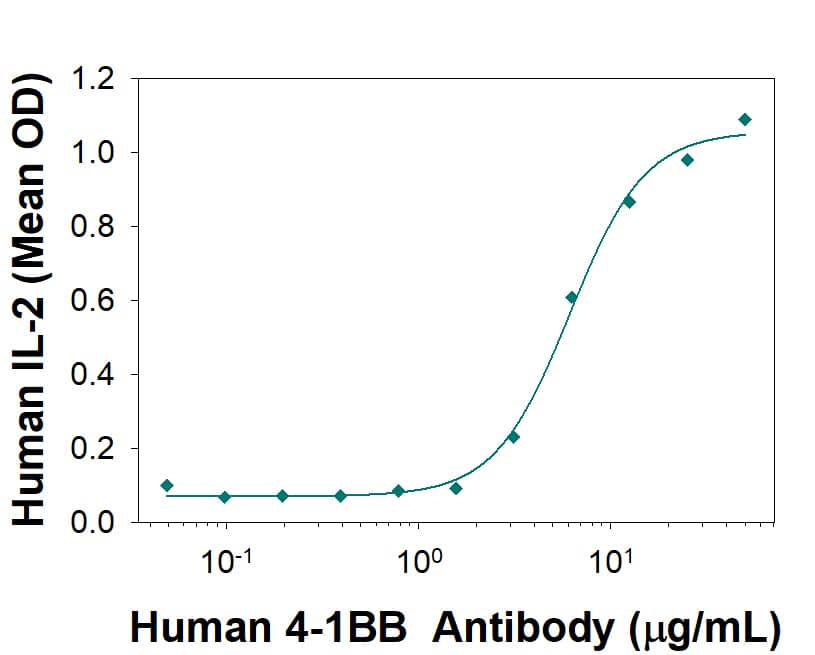Human 4-1BB/TNFRSF9/CD137 Antibody
R&D Systems, part of Bio-Techne | Catalog # MAB8382
Recombinant Monoclonal Antibody.


Conjugate
Catalog #
Key Product Details
Validated by
Biological Validation
Species Reactivity
Validated:
Human
Cited:
Human
Applications
Validated:
Agonist Activity, CyTOF-ready, Flow Cytometry
Cited:
Functional Assay
Label
Unconjugated
Antibody Source
Recombinant Monoclonal Rabbit IgG Clone # 2356C
Product Specifications
Immunogen
Chinese Hamster Ovary cell line CHO-derived human 4-1BB/TNFRSF9/CD137
Leu24-His183
Accession # Q07011
Leu24-His183
Accession # Q07011
Specificity
Detects human 4-1BB/TNFRSF9/CD137 in direct ELISAs.
Clonality
Monoclonal
Host
Rabbit
Isotype
IgG
Endotoxin Level
<0.10 EU per 1 μg of the antibody by the LAL method.
Scientific Data Images for Human 4-1BB/TNFRSF9/CD137 Antibody
Detection of 4-1BB/TNFRSF9/CD137 in Human PHA-treated PBMC by Flow Cytometry.
Human PBMC treated with PHA for 48 hr were stained with (A) Rabbit Anti-Human 4-1BB/TNFRSF9/CD137 Monoclonal Antibody (Catalog # MAB8382) or (B) Rabbit IgG control antibody (Catalog # MAB1050) followed by APC-conjugated Goat-anti Rabbit IgG secondary antibody (Catalog # F0111) and Mouse anti-Human CD3 PE-conjugated Monoclonal Antibody (Catalog # FAB100P). View our protocol for Staining Membrane-associated Proteins.Human 4-1BB/TNFRSF9/CD137 Antibody Stimulates IL-2 Secretion in Human T Cells.
Rabbit Anti-Human 4-1BB/TNFRSF9/CD137 Monoclonal Antibody (Catalog # MAB8382) co-stimulates IL-2 secretion in human T cells in the presence of anti-CD3 in a dose-dependent manner, as measured by the Human IL-2 Quantikine ELISA Kit (Catalog # D2050). The ED50 for this effect is typically 1-10 µg/mL.Applications for Human 4-1BB/TNFRSF9/CD137 Antibody
Application
Recommended Usage
Agonist Activity
Measured by its ability to co-stimulate IL-2 secretion by human T cells in the presence of anti-CD3. The ED50 for this effect is typically 1-10 μg/mL.
CyTOF-ready
Ready to be labeled using established conjugation methods. No BSA or other carrier proteins that could interfere with conjugation.
Flow Cytometry
0.25 µg/106 cells
Sample: Human PBMC treated with PHA for 48 hr
Sample: Human PBMC treated with PHA for 48 hr
Formulation, Preparation, and Storage
Purification
Protein A or G purified from cell culture supernatant
Reconstitution
Reconstitute at 0.5 mg/mL in sterile PBS. For liquid material, refer to CoA for concentration.
Formulation
Lyophilized from a 0.2 μm filtered solution in PBS with Trehalose. *Small pack size (SP) is supplied either lyophilized or as a 0.2 µm filtered solution in PBS.
Shipping
Lyophilized product is shipped at ambient temperature. Liquid small pack size (-SP) is shipped with polar packs. Upon receipt, store immediately at the temperature recommended below.
Stability & Storage
Use a manual defrost freezer and avoid repeated freeze-thaw cycles.
- 12 months from date of receipt, -20 to -70 °C as supplied.
- 1 month, 2 to 8 °C under sterile conditions after reconstitution.
- 6 months, -20 to -70 °C under sterile conditions after reconstitution.
Background: 4-1BB/TNFRSF9/CD137
4-1BB activation enhances CD8+ T cell and NK cell mediated anti-tumor immunity (14). It also contributes to the development of inflammation in high fat diet-induced metabolic syndrome (15). Soluble forms of 4-1BB and 4-1BB Ligand circulate at elevated levels in the serum of rheumatoid arthritis and hematologic cancer patients, respectively (16, 17).
References
- Wang, C. et al. (2009) Immunol. Rev. 229:192.
- Schwarz, H. et al. (1993) Gene 134:295.
- Alderson, M.R. et al. (1994) Eur. J. Immunol. 24:2219.
- Wen, T. et al. (2002) J. Immunol. 168:4897.
- Pulle, G. et al. (2006) J. Immunol. 176:2739.
- Zheng, G. et al. (2004) J. Immunol. 173:2428.
- Kim, D. et al. (2008) J. Immunol. 180:2062.
- Lee, S. et al. (2008) Nat. Immunol. 9:917.
- Choi, B.K. et al. (2009) J. Immunol. 182:4107.
- Nishimoto, H. et al. (2005) Blood 106:4241.
- Saito, K. et al. (2004) J. Biol. Chem. 279:13555.
- Lee, S. et al. (2005) J. Immunol. 174:6803.
- Ma, B.Y. et al. (2005) Blood 106:2002.
- Choi, B.K. et al. (2010) J. Immunol. 185:1404.
- Kim, C. et al. (2011) Diabetes 60:3159.
- Michel, J. et al. (1998) Eur. J. Immunol. 28:290.
- Salih, H.R. et al. (2001) J. Immunol. 167:4059.
Alternate Names
41BB, CD137, ILA, TNFRSF9
Gene Symbol
TNFRSF9
UniProt
Additional 4-1BB/TNFRSF9/CD137 Products
Product Documents for Human 4-1BB/TNFRSF9/CD137 Antibody
Product Specific Notices for Human 4-1BB/TNFRSF9/CD137 Antibody
For research use only
